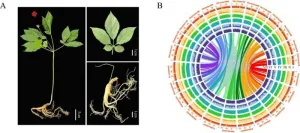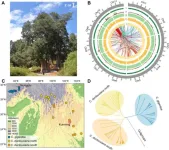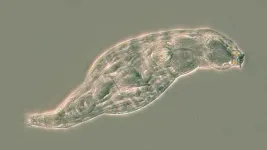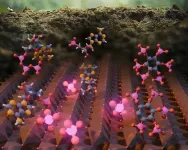(Press-News.org) A landmark study has successfully decoded the complete ginseng genome, unveiling the genetic mechanisms that govern saponin biosynthesis. This detailed genetic map illuminates the evolutionary and metabolic pathways of Panax ginseng, a staple in traditional medicine. This pivotal discovery promises to drive forward breeding initiatives and augment the plant's medicinal qualities, unlocking new possibilities for therapeutic applications.
Ginseng's role in traditional medicine is underscored by its complex genetic structure due to its allotetraploid nature. The study delves into this complexity, revealing key evolutionary insights into its subgenomes that govern saponin biosynthesis—the primary active compounds in ginseng. This necessitates deeper genetic research to fully harness ginseng's medicinal potential.
Led by Nanjing Agricultural University, this study (DOI: 10.1093/hr/uhae107) was published in the April 2024 edition of Horticulture Research. It meticulously constructed a complete 3.45 Gb genome of Panax ginseng, identifying 77,266 protein-coding genes and focusing on the pathways and biosynthesis of ginsenosides—crucial for the plant’s medicinal properties. This work significantly enhances our understanding of ginseng’s biological complexities and its therapeutic potentials.
Researchers in this study have intricately mapped ginseng's genome, identifying asymmetrical gene loss and biased gene expression across its subgenomes, dating their divergence to about 6.07 million years ago. The analysis highlights extensive gene family expansions linked to saponin biosynthesis and underscores the importance of specific gene duplications in enhancing these pathways. Comparative genomic analysis with related species provides further insight into the evolutionary tactics ginseng employs to optimize its medicinal benefits. This research not only deepens our comprehension of the ginseng genome but also establishes a crucial resource for future genetic research and the development of enhanced breeding programs.
Dr. Wei Li, the study's lead researcher, states, "This complete assembly of the ginseng genome is a monumental achievement in botanical research. It not only broadens our understanding of the genetic intricacies of medicinal plants but also introduces refined methods for cultivating ginseng varieties with superior health properties."
The comprehensive decoding of the ginseng genome sets the stage for precise breeding techniques aimed at boosting its medicinal efficacy. This research not only has immediate applications for enhancing ginseng cultivation but also serves as a model for investigating other medicinal plants, potentially revolutionizing pharmacology and crop enhancement strategies with natural products.
###
References
DOI
10.1093/hr/uhae107
Original Source URL
https://doi.org/10.1093/hr/uhae107
Funding information
This work is supported by the National Key R&D Program of China (grant nos 2020YFA0907900 and 2022YFD1700200), Agricultural Genomics Institute at Shenzhen (AGIS-ZLXM202204), Science and Technology Development Project of Jilin Province (20210509022RQ).
About Horticulture Research
Horticulture Research is an open access journal of Nanjing Agricultural University and ranked number one in the Horticulture category of the Journal Citation Reports ™ from Clarivate, 2022. The journal is committed to publishing original research articles, reviews, perspectives, comments, correspondence articles and letters to the editor related to all major horticultural plants and disciplines, including biotechnology, breeding, cellular and molecular biology, evolution, genetics, inter-species interactions, physiology, and the origination and domestication of crops.
END
Ginseng's full genome sequenced: unraveling the roots of a medicinal marvel
2024-07-18
ELSE PRESS RELEASES FROM THIS DATE:
Against the odds: The genetic secrets of a rare conifer's climate change defiance
2024-07-18
In a remarkable twist of evolutionary adaptation, the rare Tibetan cypress, Cupressus gigantea, has shown unexpected genetic resilience. Despite facing the brink of extinction due to climate change and habitat loss, the species has experienced a significant reduction in harmful genetic mutations. This discovery sheds new light on the complex interplay between genetic diversity and population decline, challenging conventional understandings of genetic load in endangered species.
Conifers, including Cupressus species, are ecologically and culturally significant, but many are threatened by climate change and human activities. ...
Hydroxyurea does not reduce ovarian reserve in female patients with SCD
2024-07-18
(WASHINGTON, July 18, 2024) – In female patients living with sickle cell disease (SCD), hydroxyurea had no effect on ovarian reserve, suggesting that fertility preservation measures prior to treatment may be unnecessary, according to a study published in Blood Advances.
SCD is the most common inherited red blood cell disorder in the United States, affecting an estimated 100,000 people. According to the Centers for Disease Control and Prevention (CDC), SCD affects one out of every 365 Black or African American births and one out ...
A “wrenaissance” for House Wrens; species and genus splits for Barn Owls and Plovers; and lumping of Redpolls included in 2024 Check-list changes
2024-07-18
CHICAGO — July 18, 2024 — The 65th Supplement to the American Ornithological Society’s (AOS’s) Check-list of North American Birds, published today in Ornithology, includes several updates to the classifications of bird species found in North America, Central America, and the Caribbean.
A few highlights from this year’s supplement, detailed below, include species splits for Troglodytes aedon (House Wren) and Tyto alba (Barn Owl); a lumping of Acanthis flammea (Common Redpoll), Acanthis ...
NFCR welcomes two new Board of Directors
2024-07-18
Rockville, MD – July 18, 2024
The National Foundation for Cancer Research (NFCR) announced new Board of Directors members today who both have been long-term supporters of the organization: Silas Deane, Vice President, Tyler Technologies, and Dr. Padmakumar Kaimal, previous Vice President of Technology Alliance & Business Development at Suven Life Sciences. The areas of expertise and leadership they bring to NFCR signify a pivotal moment for the organization working to advance the mission of providing new areas of hope and solutions for cancer patients worldwide.
Silas Deane has extended expertise in technology, healthcare, government relations, ...
In decade-first for Japan, Kyushu U Professor is elected as International Fellow of the British Academy
2024-07-18
Fukuoka, Japan — On 17 July 2024, the British Academy held its Annual General Meeting, where Koji Mizoguchi, Professor of Archaeology at Kyushu University's Faculty of Social and Cultural Studies, was elected as an International Fellow. He is the first Japanese archaeologist and the first researcher from Kyushu University to receive this honor.
Founded in 1902, the British Academy aims to deepen and share understanding of people, societies, and cultures across time and place, enabling ...
PEPITEM – a novel protective agent for inflammageing
2024-07-18
A naturally occurring peptide called PEPITEM could potentially rejuvenate the immune response in older individuals and protect against 'inflammageing', which is widely believed to be the root cause of many age-related diseases.
The study, published today in the journal npj Aging, raises the exciting possibility of a protective agent that could dampen age-related inflammation and restore normal immune function in older adults.
PEPITEM (Peptide Inhibitor of Trans-Endothelial Migration) was initially identified at the University ...
Small animals acquire genes from bacteria that can produce antibiotics
2024-07-18
WOODS HOLE, Mass. -- A group of small, freshwater animals protect themselves from infections using antibiotic recipes “stolen” from bacteria, according to new research by a team from the University of Oxford, the University of Stirling and the Marine Biological Laboratory (MBL), Woods Hole.
The tiny creatures are called bdelloid rotifers, which means ‘crawling wheel-animals’. They have a head, mouth, gut, muscles and nerves like other animals, though they are smaller than a hair’s breadth.
When these rotifers are exposed to fungal infection, the study found, ...
Unexpected role of OTX2 drives aggressive medulloblastoma
2024-07-18
In a report published in Nature Cell Biology, researchers at Baylor College of Medicine, Texas Children’s Hospital, the University of Manitoba and collaborating institutions revealed an unexpected way in which the protein OTX2 drives the progression of medulloblastoma – the most common aggressive childhood brain cancer. The findings suggest that targeting OTX2 or its effects can have therapeutic relevance.
“We see medulloblastoma stem cells as the root of the disease. The tumors develop from these cells early during development of the cerebellum, the brain region ...
Study shows new efficiency standards for heavy trucks could boost energy use
2024-07-18
Deliveries are getting faster than ever in the U.S., but the faster movement of goods is undercutting the country’s climate progress.
In a new study published July 18 in the journal Nature Energy, a CU Boulder researcher and his collaborator estimate that federal regulations aimed at enhancing heavy-duty trucks’ energy efficiency could be as much as 20% less effective than policymakers initially anticipated.
That’s because the regulations make trucking cheaper. As a result, more shippers will likely switch from using less energy-intensive rail transportation to using more energy-intensive trucks to ship goods.
“We ...
Minerals play newly discovered role in Earth’s phosphorus cycle
2024-07-18
Northwestern University-led researchers have discovered a new way that nature cycles phosphorus, a finding that uncovers a missing piece of Earth’s puzzling phosphorus cycle.
The research will be published on Thursday (July 18) in the journal Nature Communications.
A critical nutrient for plant growth, phosphorus is a non-negotiable component of fertilizers. Without it, farmers cannot ensure plant health and boost crop yields. Understanding Earth’s phosphorus cycle, therefore, is important for protecting the global food supply.
Although ...




